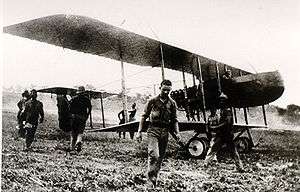Farman F.40
| F.40 | |
|---|---|
 | |
| Portuguese Farman F.40 in Mozambique, during the East African Campaign of World War I | |
| Role | reconnaissance/observation biplane |
| Manufacturer | Farman Aviation Works |
| Designer | Henry Farman |
| Introduction | 1915 |
| Retired | 1922 |
|
| |
The Farman F.40 was a French pusher biplane reconnaissance aircraft.
Development
Developed from a mix of the Maurice Farman designed MF.11 and the Henry Farman designed HF.22, the F.40 (popularly dubbed the Horace Farman) had an overall smoother outline and smoother crew nacelle. A pair of upper tail booms supported a horizontal tailplane and a curved fin. The aircraft went into production in 1915.
Operational history
Forty French Air Force escadrilles (squadrons) were equipped with F.40s. They operated for just over a year, but were replaced in early 1917.
The F.40 was also operated by the No. 5 Wing of the Royal Naval Air Service, Belgian forces in France, and also by the Russians
Italian aircraft maker Savoia-Marchetti built F.40s for use by the police force until 1922.
Variants
- F.40P - adaption to fire Le Prieur rockets
- F.41 - shorter wingspan
- F.56 - larger 127-kW (170-hp) Renault engine
- F.60 - larger 142-kW (190-hp) Renault engine
- F.61 - F.41 with 142-kW (190-hp) Renault engine
Operators
- Royal Netherlands Air Force One aircraft only.
- Soviet Air Force - Taken over for the Russian Air Force.
- Venezuelan Air Force - Two aircraft only.
- Venezuelan Navy
Specifications
Data from [1]
General characteristics
- Capacity: 2
- Length: 9.25 m (30 ft 4.25 in)
- Wingspan: 17.6 m (57 ft 9 in)
- Height: 3.9 m (12 ft 9.5 in)
- Wing area: 52 m2 (559.74 ft2)
- Empty weight: 748 kg (1649 lb)
- Gross weight: 1120 kg (2469 lb)
- Powerplant: 1 × Renault 12-cylinder Vee piston, 101 kW (135 hp) each
Performance
- Maximum speed: 135 km/h (84 mph)
- Endurance: 2 hours 20 min
- Service ceiling: 4,000 m (13,125 ft)
Armament
- 1 or 2 × 7.7-mm (0.303 in) machine-guns in observer's cockpit
- light bombs or 10 × Le Prieur rockets
- Aircraft of comparable role, configuration and era
References
| Wikimedia Commons has media related to Farman MF40. |